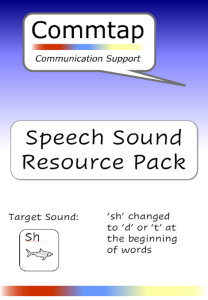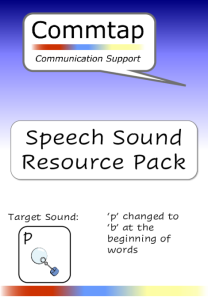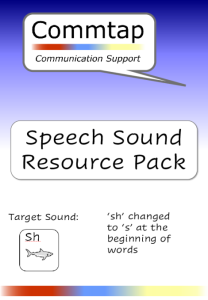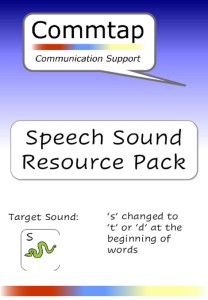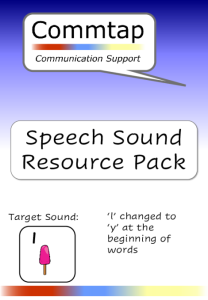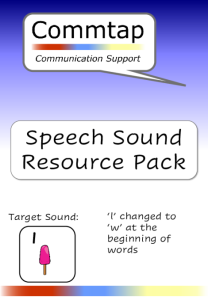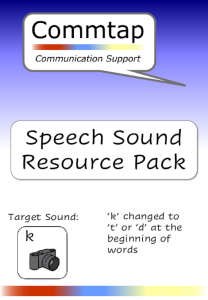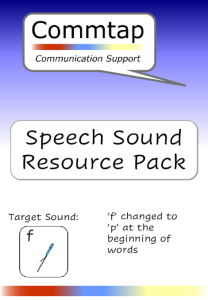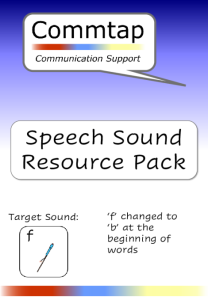Search
User login
Use 'sh' Instead of 't' or 'd' - Word Initial Speech Sound Pack
Support a child who is using "t" or "d" instead of "sh" in their speech. This pack takes you through the following steps:
- Building awareness of sounds
- Saying "sh" on its own
- Saying "sh" with a vowel
- Using "sh" in individual words
- Using "sh" in words in phrases
- Using "sh" in sentences
- Using "sh" in conversations
Created 29 May 2023; updated 9 June 2023.
Use 'p' Instead of 'b' - Word Initial Speech Sound Pack
Support a child who is using "b" instead of "p" in their speech. This pack takes you through the following steps:
- Building awareness of sounds
- Saying "p" on its own
- Saying "p" with a vowel
- Using "p" in individual words
- Using "p" in words in phrases
- Using "p" in sentences
- Using "p" in conversations
Created 29 May 2023; updated 26 October 2023.
Speech Sound Packs
Commtap have developed a set of speech sound packs that can be used to work through all the stages of learning a new sound.
Sound to Develop:
s
-s changed to t or d at the beginning of words
-s changed to c/k at the beginning of words
Use 'sh' Instead of 's' - Word Initial Speech Sound Pack
Support a child who is using "s" instead of "sh" in their speech. This pack takes you through the following steps:
- Building awareness of sounds
- Saying "sh" on its own
- Saying "sh" with a vowel
- Using "sh" in individual words
- Using "sh" in words in phrases
- Using "sh" in sentences
- Using "sh" in conversations
Created 29 May 2023; updated 9 June 2023.
Use 's' Instead of 't' or 'd' - Word Initial Speech Sound Pack
Support a child who is using "t" or "d" instead of "s" in their speech. This pack takes you through the following steps:
- Building awareness of sounds
- Saying "s" on its own
- Saying "s" with a vowel
- Using "s" in individual words
- Using "s" in words in phrases
- Using "s" in sentences
- Using "s" in conversations
Created 29 May 2023; updated 9 June 2023.
Use 's' Instead of 'k' - Word Initial Speech Sound Pack
Support a child who is using "k" instead of "s" in their speech. This pack takes you through the following steps:
- Building awareness of sounds
- Saying "s" on its own
- Saying "s" with a vowel
- Using "s" in individual words
- Using "s" in words in phrases
- Using "s" in sentences
- Using "s" in conversations
Created 29 May 2023; updated 9 June 2023.
Use 'L' Instead of 'y' - Word Initial Speech Sound Pack
Support a child who is using "y" instead of "l" in their speech. For example saying "yook" instead of "look". This pack takes you through the following steps:
- Building awareness of sounds
- Saying "l" on its own
- Saying "l" with a vowel
- Using "l" in individual words
- Using "l" in words in phrases
- Using "l" in sentences
- Using "l" in conversations
Created 29 May 2023; updated 9 June 2023.
Use 'L' Instead of 'w' - Word Initial Speech Sound Pack
Support a child who is using "w" instead of "l" in their speech. For example saying "wight" instead of "light". This pack takes you through the following steps:
- Building awareness of sounds
- Saying "l" on its own
- Saying "l" with a vowel
- Using "l" in individual words
- Using "l" in words in phrases
- Using "l" in sentences
- Using "l" in conversations
Created 29 May 2023; updated 9 June 2023.
Use 'L' Instead of 'n' - Word Initial Speech Sound Pack
Support a child who is using "n" instead of "l" in their speech. For example saying "night" instead of "light". This pack takes you through the following steps:
- Building awareness of sounds
- Saying "l" on its own
- Saying "l" with a vowel
- Using "l" in individual words
- Using "l" in words in phrases
- Using "l" in sentences
- Using "l" in conversations
Created 29 May 2023; updated 9 June 2023.
Use 'k' Instead of 't' or 'd' - Word Initial Speech Sound Pack
Support a child who is using "t" or "d" instead of "k" in their speech. This pack takes you through the following steps:
- Building awareness of sounds
- Saying "k" on its own
- Saying "k" with a vowel
- Using "k" in individual words
- Using "k" in words in phrases
- Using "k" in sentences
- Using "k" in conversations
Created 29 May 2023; updated 28 December 2023.
Use 'f' Instead of 's' - Word Initial Speech Sound Pack
Support a child who is using "s" instead of "f" in their speech. This pack takes you through the following steps:
- Building awareness of sounds
- Saying "f" on its own
- Saying "f" with a vowel
- Using "f" in individual words
- Using "f" in words in phrases
- Using "f" in sentences
- Using "f" in conversations
Created 29 May 2023; updated 9 June 2023.
Use 'ch' Instead of 'd' or 't' - Word Initial Speech Sound Pack
Support a child who is using "t" or "d" instead of "ch" in their speech. This pack takes you through the following steps:
- Building awareness of sounds
- Saying "ch" on its own
- Saying "ch" with a vowel
- Using "ch" in individual words
- Using "ch" in words in phrases
- Using "ch" in sentences
- Using "ch" in conversations
Created 29 May 2023; updated 9 June 2023.
Use 'f' Instead of 'p' - Word Initial Speech Sound Pack
Support a child who is using "p" instead of "f" in their speech. This pack takes you through the following steps:
- Building awareness of sounds
- Saying "f" on its own
- Saying "f" with a vowel
- Using "f" in individual words
- Using "f" in words in phrases
- Using "f" in sentences
- Using "f" in conversations
Created 29 May 2023; updated 9 June 2023.
Use 'f' Instead of 'b' - Word Initial Speech Sound Pack
Support a child who is using "b" instead of "f" in their speech. This pack takes you through the following steps:
- Building awareness of sounds
- Saying "f" on its own
- Saying "f" with a vowel
- Using "f" in individual words
- Using "f" in words in phrases
- Using "f" in sentences
- Using "f" in conversations
Created 29 May 2023; updated 9 June 2023.
Commtap Newsletter Sign Up
Sign up our newsletter for occasional information about new resources and other developments
Support Commtap to keep it online
Thank you for visiting Commtap.
Please read this message as it is extremely important.
- Visitor donations mean we can continue to host over 1,000 free activities to support speech, language, and communication development.
- Visitor donations mean we can continue to provide free resources to address a wide range of communication needs, including limited speech or language, interaction challenges, and needs associated with conditions such as developmental language disorder, autism, and cerebral palsy.
- Visitor donations mean we can continue to provide resources to support the work of speech and language therapists, teachers, teaching assistants, parents, and carers.
- Visitor donations mean we can continue to provide the free key word sign dictionary (bks.org.uk) which has over 2,000 Makaton and Signalong signs.
We know that not everyone is able to afford to pay to access these resources, however, if you can, please make a donation to keep the site going.
Thank you
Google ads on this page are provided by Google Adsense - and their presence does not imply any endorsement by Commtap. Report a problem with an ad on this page. Log in (for free) to avoid seeing Google ads.
